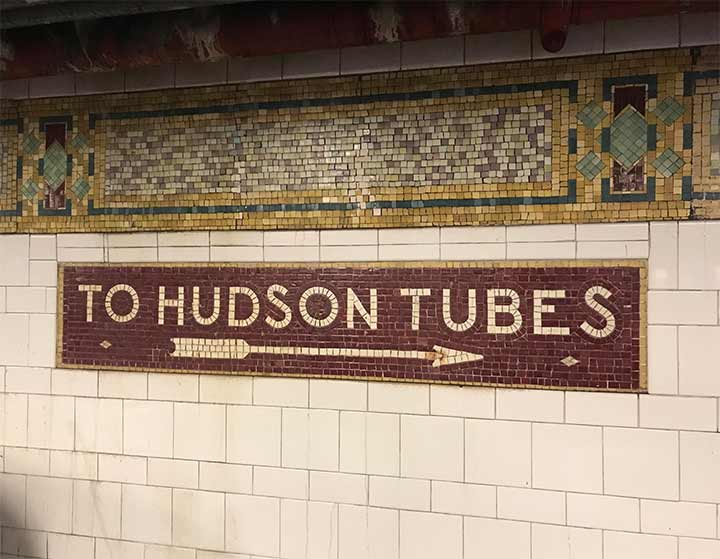
GLAD to get out of the house for the first time in a couple of weeks (I’m “chained to the computer” at home during the week, and the weekends have been rainy) I found a subway transfer I had never attempted before. (Andy Sparberg, fill me in on how old this transfer is) See Comments below
Headed for Battery Park, the #1 wasn’t going there and the friendly announcement informed us to transfer to the R at Park Place. Park Place? Yes indeed. From the IRT, you go through a secret passageway to the IND E train terminal station at World Trade Center and then walk the length of the platform, which gets you to the south end of the BMT Cortlandt Street platform.
It’s there you find mosaic signs pointing to the “Hudson Tubes” which is a euphemism for the PATH train (which stands for Port Authority Trans-Hudson). The IND, constructed some years after the BMT, calls the PATH trains its original name as conceived in 1908, the Hudson-Manhattan Railroad. The Cortlandt Street station was opened in 1918, renovated in 1998, closed for some months after the 9/11/01 terrorist attack, and then closed again for a few years so a corridor could be built to the Fulton Transit Center. Through all of it the “Hudson Tubes” mosaics have been retained, and people know what they mean.

I have mentioned the Rector Street BMT station (R, W) before but I’m fascinated with it since it’s a holdout of sorts. In 1970. local stations on the 4th Avenue/Broadway BMT got a makeover which made them look like nothing else in the subways at the time. The mosaics and original tiling were covered over with white blocks interspersed with unicolored blocks on which were affixed station signage. Originally the signs were white with black letters in the Standard font the MTA was using, but when black signs, white letters and Helvetica became the MTA standard the signs were changed. The color blocks were in 4 different colors, red, blue, gold and gray and were installed in that sequence. One exception was 49th Street Manhattan, which was designed by Philip Johnson and employed burnt orange, which was a hot color for the MTA in the 1970s.
In the 1990s, Manhattan stations… except for Rector Street… had their 1970 tiles and signs unceremoniously removed and the mosaics beneath were cleaned and restored where necessary.
As always, “comment…as you see fit.” I earn a small payment when you click on any ad on the site.
1/22/22


6 comments
“Hudson Tubes” was not a BMT euphemism, it was what the Hudson & Manhattan Railroad was commonly known as before it was taken over by the Port Authority and renamed PATH. I knew it as the Hudson Tubes well before I knew it by any other name. My parents called it that in from their childhood in the 1930’s and 40’s.
Too bad they haven’t done anything for the garish 49th street. What were they thinking?
Kevin, Andy Sparberg here. Thanks for the “advertisement.”
Part of this transfer has been around almost as long as I’ve been around; the other part happened very recently. The IRT-IND free transfer at Park Place/Chambers St. opened July 1, 1948, one of fourteen such inter-divisional connections (IND-IRT-BMT) that debuted on that date. The IRT is deep below the IND here, necessitating the steep stairs.
The reason for creating the fourteen free transfer points was an increase in the basic subway fare from five to ten cents, which at the time was a history making event because the “nickel ride” had become a virtual entitlement. The idea was to remove barriers where the physical connection was already there but turnstiles required a second fare payment. Thus transferring passengers no longer had to pay a second fare, and for them there was no fare increase that date. Times Square and Herald Square are probably the best examples of where the free transfers had the most impact; Grand Central wasn’t affected because it was always IRT only.
The free transfer between the south end of the E train and the R train is only a few years old, a product of the rebuilding of the World Trade Center complex. This transfer wasn’t much more that the breaking of a wall between the two stations, easily accomplished during the Occulus construction. I worked at the original WTC for nearly eight years (1974-82) and always thought that such a transfer would have made sense, except that at the original WTC a large bank branch was in the way of this path (pun somewhat intended).
Source for IRT-IND transfer is my own book, From a Nickel to a Token. If I can find out the exact date the E – R transfer opened, I’ll post it here.
Replying to my own comment, with assistance from Subchat.com – the E – R free transfer at World Trade Center/Oculus opened December 29, 2017, so it’s been four years and a month.
The Bowling Green IRT station got the same burnt-orange treatment as 49th Street, and I kind of like both of them. Gives them a 1970s version of what a futuristic station would like like. Bowling Green also had some round, scalloped seating that looked like a UFO from the future.
Ive seen that sign dozens of times and it never occured
to me how strange it had 2 names.I think because Ive
seen different names for the same place in NY before.
I first saw the sign in ’64,never gave it a second thought
The Path trains were so clean and the stations too
compared to the subway.
And on the old Erie-Lackawanna trains in NJ,when you
looked down at the toilet bowl in the “restrooms” you
could see the train tracks go by.thats right,your doodies
met an ignominous death on the tracks